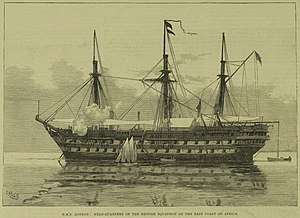This is an old revision of this page, as edited by Hms1840london (talk | contribs) at 05:16, 3 December 2014. The present address (URL) is a permanent link to this revision, which may differ significantly from the current revision.
Revision as of 05:16, 3 December 2014 by Hms1840london (talk | contribs)(diff) ← Previous revision | Latest revision (diff) | Newer revision → (diff) For other ships with the same name, see HMS London. HMS London depicted in Zanzibar 1881 HMS London depicted in Zanzibar 1881
| |
| History | |
|---|---|
| Name | HMS London |
| Builder | Chatham dockyard |
| Laid down | October 1827 |
| Launched | 28 September 1840 |
| Fate | Sold for breaking up, 1884 |
| Notes | Converted to a 72-gun third rate screw ship, 1858 |
| General characteristics | |
| Class and type | Rodney class ship of the line |
| Tons burthen | 2598 bm |
| Length | 205 ft 6 in (62.64 m) (gundeck) |
| Beam | 54 ft 5 in (16.59 m) |
| Depth of hold | 23 ft 2 in (7.06 m) |
| Propulsion | Sails (and steam, after 1858) |
| Sail plan | Full rigged ship |
| Armament | list error: mixed text and list (help) As second rate, 90 guns:
|
HMS London was a two-decker 90-gun second rate ship of the line of the Royal Navy, launched on 28 September 1840 at Chatham Dockyard.
In 1854, London took part in the bombardment of Fort Constantine at Sevastopol during the Crimean War, where she sustained damage.
In 1858 she was converted to screw propulsion, and reduced to 72 guns.
By 1873, she was a hulk, serving as a depot ship in Zanzibar Bay, off the east coast of Africa. In March 1878 she was recommissioned, and involved in the suppression of the slave trade in the area, serving as a central depot for many smaller steam screw boats; she functioned as a repair depot, a hospital and a storage ship. At this time there were Africans from West Africa (Kroomen or Krumen) and East Africa (Seedies or Sidis) serving on board. There were also Zanzibari and Arab interpreters and cooks from Portuguese Goa (India).

Captained by Charles J Brownrigg, this vessel and her crew made several patrols aimed at hindering the slave trade and, on 3 December 1881, caught up with a slave dhow captained by Hindi bin Hattam. This dhow had around 100 slaves on board and was transporting them between Pemba and Zanzibar. Captain Brownrigg led a boarding party to release the slaves but bin Hattam's men then attacked the sailors, killing Brownrigg and some of his party before sailing away. Sir Lloyd William Mathews led a force to Wete on Pemba and, after a short battle, took a mortally wounded bin Hattem (Hindi-bin-Khartoum) prisoner before returning to Zanzibar.
The final entry in the ships log is dated 22 January 1883. Captain Luxmoore writes "Paid ship off" "Sent ships company to transport Windsor Castle in passage to England".
In 1884 she was sold and broken up.
| List of Pinnace (ship's boat) attached to HMS London,
Sept 1880 to Sept 1882 | |
|---|---|
| Boat | Notes |
| Helena | |
| L. Cutter | |
| Beatrice | |
| Victoria | |
| Depot | |
| L. Pinnace | |
| Wave | |
| Alexandra | |
| Sunbeam | |
| Alice | |
| L. Launch | |
| Galley | |
| Mermaid | |
Notes
- ^ Lavery, Ships of the Line vol.1, p190.
- House of Commons papers, vol 66, pg189.
- https://en.wikipedia.org/File:DhowCaptures1881.jpg
References
- Lavery, Brian (2003) The Ship of the Line - Volume 1: The development of the battlefleet 1650-1850. Conway Maritime Press. ISBN 0-85177-252-8.
- House of Commons papers by Great Britain. Parliament. (1883), vol. 66, p. 189.